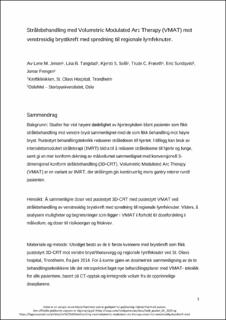| dc.contributor.author | Jensen, Lene Merete | |
| dc.contributor.author | Tangstad, Lise Berg | |
| dc.contributor.author | Solli, Kjersti Sund | |
| dc.contributor.author | Frøseth, Trude Camilla Salvesen | |
| dc.contributor.author | Sundqvist, Eric | |
| dc.contributor.author | Frengen, Jomar | |
| dc.date.accessioned | 2021-11-10T09:10:43Z | |
| dc.date.available | 2021-11-10T09:10:43Z | |
| dc.date.created | 2021-01-12T10:50:47Z | |
| dc.date.issued | 2020-10-26 | |
| dc.identifier.issn | 0332-9410 | |
| dc.identifier.uri | https://hdl.handle.net/11250/2828827 | |
| dc.description.abstract | Bakgrunn: Studier har vist høyere dødelighet av hjertesykdom blant pasienter som fikk strålebehandling mot venstre bryst sammenlignet med de som fikk behandling mot høyre bryst. Pustestyrt behandlingsteknikk reduserer stråledosen til hjertet. I tillegg kan bruk av intensitetsmodulert stråleterapi (IMRT) bidra til å redusere stråledosene til hjerte og lunge, samt gi en mer konform dekning av målvolumet sammenlignet med konvensjonell 3-dimensjonal konform strålebehandling (3D-CRT). Volumetric Modulated Arc Therapy (VMAT) er en variant av IMRT, der strålingen gis kontinuerlig mens gantry roterer rundt pasienten. Hensikt: Å sammenligne doser ved pustestyrt 3D-CRT med pustestyrt VMAT ved strålebehandling av venstresidig brystkreft med spredning til regionale lymfeknuter. Videre, å analysere muligheter og begrensninger som ligger i VMAT i forhold til dosefordeling i målvolum, og doser til risikoorgan og friskvev. Materiale og metode: Utvalget besto av de ti første kvinnene med brystkreft som fikk pustestyrt 3D-CRT mot venstre bryst/thoraxvegg og regionale lymfeknuter ved St. Olavs hospital, Trondheim, fra juni 2014. For å kunne gjøre en dosimetrisk sammenligning av de to behandlingsteknikkene ble det retrospektivt laget nye behandlingsplaner med VMAT- teknikk for alle pasientene, basert på CT-opptak og inntegnede volum fra de opprinnelige doseplanene. Resultat og konklusjon: Homogenitetsindeksen (HI) var lik for begge teknikkene, mens konformitetsindeksen (CI) var signifikant (p<0,001) bedre med VMAT. Dosedekningen av PTV var lavere ved VMAT (D98% =87,73 %) i forhold til ved 3D-CRT (D98% =89,38 %). Ved pustestyrt VMAT var maksimumsdoser til hjertet signifikant lavere enn ved konvensjonell 3D-CRT. VMAT ga også lavere gjennomsnittsdoser til hjertet. I tillegg var V40 Gy betydelig mindre ved VMAT. Ulempen ved bruk av VMAT, sammenlignet med 3D-CRT, var økte doser til høyre bryst og høyre lunge. | en_US |
| dc.description.abstract | Background: Studies have shown an increased mortality from heart disease among patients who received radiation therapy for left sided breast cancer, compared to right sided. Breathing guided radiotherapy reduces the radiation dose to the heart. In addition, the use of Intensity Modulated Radiotherapy (IMRT) may reduce the doses to the heart and lung, as well as increasing the conformity compared to conventional 3-Dimensional Conformal Radiation Therapy (3D-CRT). Volumetric Modulated Arc Therapy (VMAT) is a variant of IMRT, where the radiation is given continuously while the gantry rotates around the patient. Purpose: To do a dosimetric comparison between breathing guided 3D-CRT and breathing guided VMAT for locally advanced left sided breast cancer patients. Furthermore, to investigate the possibilities and limitations of VMAT in terms of dose distribution in the target volume and doses to organs at risk and healthy tissue. Material and methods: This study includes the first 10 women with locally advanced left sided breast cancer who received breathing guided 3D-CRT radiotherapy at St. Olav's Hospital in Trondheim, from June 2014. In order to do a dosimetric comparison of the two treatment modalities, new treatment plans with VMAT-technique were retrospectively created for all patients, based on the original CT-images and treatment planning volumes. Results and conclusion: The homogeneity index (HI) was equal for the two techniques, while the conformity index (CI) was significantly (p<0,001) lower with VMAT. The PTV dose coverage was lower for VMAT (D98%=87, 73%) compared to 3D-CRT (D98%=89, 34%). Breathing guided VMAT resulted in a significantly lower maximum dose to the heart compared to 3D-CRT. VMAT also gave lower average doses to the heart. In addition, the use of VMAT reduced the patient volume receiving doses of 40 Gy or more. The observed disadvantages when using VMAT, compared to 3D-CRT, were increased dose to the right breast and right lung. | en_US |
| dc.language.iso | nob | en_US |
| dc.publisher | Norsk Radiografforbund | en_US |
| dc.relation.ispartofseries | Hold Pusten;Nr. 5 - 2020 - 47. årgang | |
| dc.relation.uri | https://fagpressenytt.no/artikkel/str%C3%A5lebehandling-med-volumetric-modulated-arc-therapy-vmat-mot-venstresidig-brystkreft-med | |
| dc.relation.uri | https://issuu.com/holdpusten.no/docs/hold_pusten_05_2020 | |
| dc.subject | Strålebehandling | en_US |
| dc.subject | Hjertesykdommer | en_US |
| dc.subject | Brystkreft | en_US |
| dc.subject | Behandlingsteknikker | en_US |
| dc.subject | Lymfeknuter | en_US |
| dc.title | Strålebehandling med Volumetric Modulated Arc Therapy (VMAT) mot venstresidig brystkreft med spredning til regionale lymfeknuter | en_US |
| dc.title.alternative | Volumetric Modulated Arc Therapy (VMAT) på venstresidig brystkreft med spredning til regionale lymfeknuter | en_US |
| dc.type | Peer reviewed | en_US |
| dc.type | Journal article | en_US |
| dc.description.version | acceptedVersion | en_US |
| cristin.ispublished | true | |
| cristin.fulltext | preprint | |
| cristin.qualitycode | 1 | |
| dc.identifier.doi | https://fagpressenytt.no/artikkel/str%C3%A5lebehandling-med-volumetric-modulated-arc-therapy-vmat-mot-venstresidig-brystkreft-med | |
| dc.identifier.cristin | 1869679 | |
| dc.source.journal | Hold Pusten | en_US |
| dc.source.volume | 47 | en_US |
| dc.source.issue | 5 | en_US |
| dc.source.pagenumber | 19-25 | en_US |
